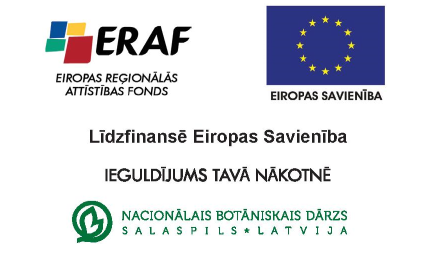Department head
Zane Purne, mob. phone 28328819, zane.purne@nbd.gov.lv
Work directions
Collections of orangery (hothouse) plants
Сollections in charge, short description
The beginning of the collections goes back to 1956. On the 23 of April 2015 the new Conservatory complex was opened to public. The building work executed by firm “EKOTEH” was started in 2013 in the framework of the project “Creation of infrastructure for biological diversity conservation ex situ” by financial support of European Regional Development Fund. Common financial investment – 3, 4 milj. EUR.
Every year collections are replenished with the plants grown from the seeds and cuttings get in the international seed exchange. At present there are about 2100 plant taxa from all continents except Antarctiсa.
Especial pride of the Orangery is collection of succulents. Research and growing of succulent plants in the Botanic garden started in the 60-ies of the last century, when Cactaceae and Crassulaceae families were proven experimentally for their drought-resistance and suitability for growing as houseplants.
In the orangery one can observe succulents of сonsiderable age and size (cacti, aloes and agaves, Portulacea crassula, grown here since 1958, and other). There are some Crassulaceae plants formed as bonsai trees, as well as professionally formed succulent and epiphytic plant compositions.
There are considerable collections of agaves and aloes containing more as 30 species each. Gasterias (20 species), peperomias (20 taxa), kalanhoes (15 taxa), euphorbias (13 species), as well as sansevieras, bovias and other.
In the cacti collection there are more than 500 taxa. There are also Crassulaceae plants: more as 50 Crassula, 40 Sedum, 20 Aeonia, Monanthes, Cotiledons, Esheverias, 17 taxa of Portulacaceae, 21 species of Senecio, 11 Ceropegias.
One of the oldest and most nothewort trees is the dragontree Dracaena draco from Canary islands, which is 49 jears old and more as 3 m high.
There are also other Dracaenas, as well their American relatives – Nolinas, and similar lookingJuccas. South American and Central American provenience have also spiny trees Chorisias, mimosa-leaved Jacarandas, jellow flowered Cassias and bright flowered lianas – Brunfelsias and Bouganvilleas.
From the tropics of Australia are trees with the big leaves Brahihitons, unuseful conifers Araucaruas, Casuarinas, looking like big horsetails, as well bottle trees Calistemons.
Asian provenience have Euonymus, Schefflera, coniferous trees Criptomerias, Cephalotaxus. From Mediterranean region are olives, pinias, laurus, but Cusonias are from South African savannas. Through all the seasons variegated varieties of ficuses make the collection multicoluor (there are 24 taxa of Ficus, including fig tree Ficus carica).
Tropic and subtropic fruit plants – lemon, feihoa, guava, eryobotria, bananas.
In the collection of Araceae family lians are 9 filodendrons, 3 monsteras, 2 epipremnums, 2 raphydophora, and climbing anturia. Lians – Tetrastigma voineri, Stephanotes, thunbergias, Aristolochias (6 species), Dioscoreas (5 species), climbing asparagus (11 taxa), ivies and hoias, Commelinaceae climbers (tradescantias, zebrinas, callisias and cianotes – 13 taxa), as well mandevillas, wisterias a.o.
Research projects
Since 2003, a contractual research for the firm”Kano-P” – research of optimal soils for houseplants.
2011-2013 the project “SmartGarden” (Estonian-Latvian overboard co-operation project).
2008 Project supported by Latvian Environment Protection Fund – infrastructure for succulent plants.
Other information
Consulting about houseplants – oral, in the Internet, on the phone. Scientific popular articles – journals „Dārza Pasaulē”, „Dārzā un Dravā”, „Praktiskais Latvietis”, „Lauku Avīze”. Participation in the radio and TV programs about plants. Plant exhibitions.
Project „Creation of infrastructure for plant conservation ex situ is co-financed by European Union.
Finance recipient in the framework of this project is National Botanic Garden of Latvia.
Administrative, financial and technical surveillance was carried out by the Ministry of Environment Protection and Regional Development.
Investment into your future!


